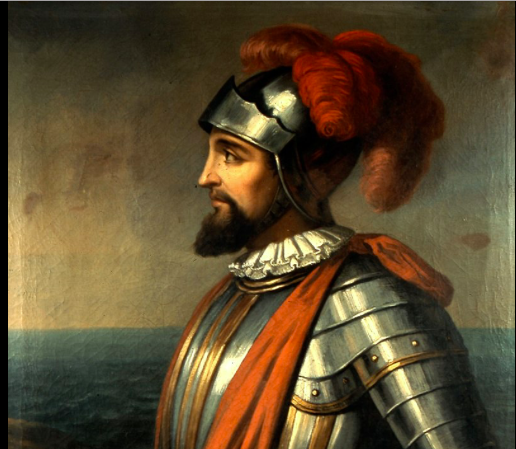
The movement to remove the names of slave owners from positions of honor has taken down individuals both famous and obscure, from Confederate General Robert E. Lee’s statutes in the South to Berkeley’s LeConte Elementary School, until recently named for the University of California’s first geology professor – who was also a slave owner and Confederate Army munitions supplier.

And yet there’s one category that seems to slip through the cracks — the conquistadors, like Balboa. San Franciscans may actually find it hard to believe that anyone could have escaped scrutiny in all of this, given that just last year the city’s School Board president floated the idea of renaming the high school named after George Washington, since the enslavement of Africans has quite rightly come to be recognized as a sort of national “original sin” and, as is widely known, the nation’s first president was also a slave owner. But there was another American original sin that has not yet received the same attention in the naming debates –- the extermination of the nation’s native population.
This issue was actually lightly touched upon in the San Francisco discussion, as one observer suggested the “need to remove the names Serra, Balboa, Ulloa, and Noriega from our schools.” The four all date from the Spanish colonial era, a period that understandably tends to draw less scrutiny because it is not strictly speaking a part of U.S. history. Antonio de Ulloa and José Antonio de la Guerra y Noriega, quite obscure names today, were once big wheels in the colonial world; Ulloa, the first Spanish governor of Louisiana and Noriega a military officer who later owned a half million acres of California.
Opinion is mixed on the much more prominent Junipero Serra, the Franciscan priest who founded the first nine of the California missions. He is literally a saint to some –- the Roman Catholic Church canonized him in 2015– while others decry his role in taking the state away from its rightful owners.
On the other hand, the most famous of the four, Vasco Núñez de Balboa, who even has a crater on the moon named after him, was an archetypical conquistador –- and no one considers him a saint. Once known as the discoverer of the Pacific Ocean, in the same way that Christopher Columbus “discovered” America, Balboa is today more appropriately described as the first European to look upon that ocean’s eastern shore. But there’s a lot more to his story.
The Encyclopedia Britannica tells us he “organized .. slave-hunting expeditions” and had an “Indian policy” included “the use of … every kind of force, including torture.” And in case you thought the “dogs of war” might just be an expression, the encyclopedia explains that the “Spanish arsenal included their terrible war dogs, sometimes used by Balboa as executioners to tear Indian victims to pieces.”
An incident described by Peter Martyr d’Anghiera in his 1530 account of Spanish exploration and conquest, On the New World, would seem to have particular resonance in San Francisco: “Vasco [Balboa] discovered that the village of Quarequa was stained by the foulest vice. The king’s brother and a number of other courtiers were dressed as women, and according to the accounts of the neighbours shared the same passion. Vasco ordered forty of them to be torn to pieces by dogs.”
And with this, d’Anghiera tells us, “the Christians” — as he routinely referred to the Spaniards –- actually found local favor: “When the natives learned how severely Vasco had treated those shameless men, they pressed about him as though he were Hercules, and spitting upon those whom they suspected to be guilty of this vice, they begged him to exterminate them, for the contagion was confined to the courtiers and had not yet spread to the people. Raising their eyes and their hands to heaven, they gave it to be understood that God held this sin in horror, punishing it by sending lightning and thunder, and frequent inundations which destroyed the crops. It was like wise the cause of famine and sickness.”
Help us save local journalism!
Every tax-deductible donation helps us grow to cover the issues that mean the most to our community. Become a 48 Hills Hero and support the only daily progressive news source in the Bay Area.
Things ultimately did not turn out well for Balboa either, though. Subsequently charged by political opponents with a list of crimes that included the mistreatment of Indians, he was beheaded following what the Britannica describes as a “farcical trial.” His head remained on public display for several days thereafter.
Is this a name that belongs on a San Francisco school?

Here’s another idea: Let’s rename San Francisco itself. A saint who inspired conquistadors to convert the native heathens, subjugate them and eventually try to exterminate them has no place in the modern world of equity.
We could always go with “Jonestown”?
He forgot to add “sarc” to his comment. As I failed to do in mine. But you raise a good point about banning Spanish. Hadn’t thought of that one. But we don’t need to go that far. Just ban Spanish names from streets and buildings.
Sounds like you would support a ban on Catholicism, and maybe a ban of the Spanish language, since conquistadors and missionaries forced natives to convert and learn Spanish! Right?
We need to go farther and tear down all the missions, everywhere in California. They’re symbols of racial and religious oppression and their very presence tears at the hearts of native people, every minute of every day.
As far as that goes, Mission Dolores is a symbol of Native American oppression. We need to remove the name Mission and Dolores from all buildings and streets.